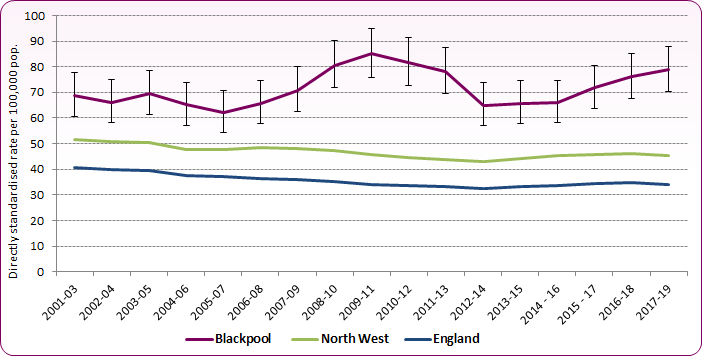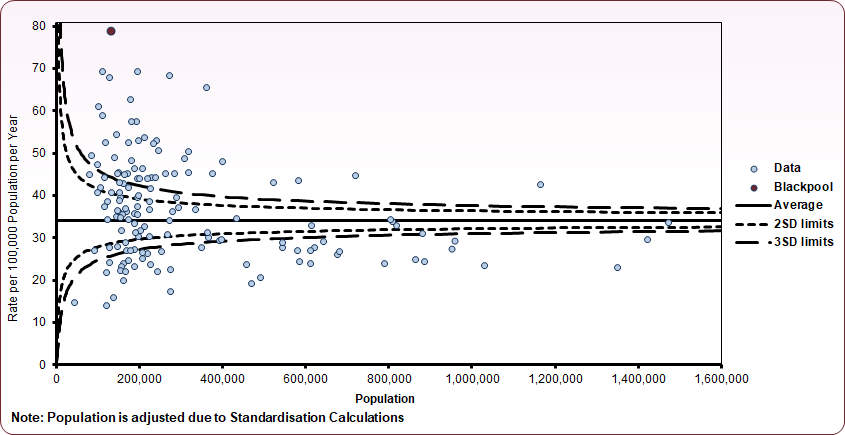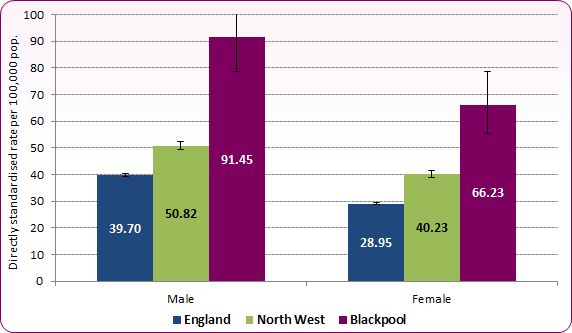Respiratory disease
Last Modified 21/11/2023 10:43:58
Share this page
Introduction
Respiratory disease is one of the top causes of death in England in people aged under-75 years. Two of the most common lung diseases are asthma and chronic obstructive pulmonary disease (COPD). Smoking is the chief cause of COPD and the Public Health Outcomes Framework1 indicator on premature mortality from respiratory disease focuses public health attention on the prevention of smoking and other environmental factors that contribute to people getting respiratory disease.
Respiratory disease and COVID-19
People with underlying respiratory and lung diseases (alongside other risk factors) are at increased risk of negative and serious outcomes from COVID-19. It was the leading cause of death in England in 2020, both directly and indirectly. The COVID-19 page has further details around the impact on Blackpool's residents.
Facts and figures
Across Blackpool in the five year period 2015 to 2019 there were 1,560 deaths from respiratory disease, approximately 312 per year. Deaths from respiratory disease for 2021show:
-
-
- 87 deaths were in people aged under 75 years (63.1 per 100,000) and 231 for all ages (153.6 per 100,000)
- The all-age and the under-75 mortality rates were significantly higher than the national average
Mortality from respiratory disease in people aged under-75 has been significantly higher in Blackpool than in the North West and England over the last 15 years (figure 1). The main contributor to this is the high levels of smoking in the town. When compared to other upper tier local authorities, Blackpool's mortality rate is the highest in the country (figure 2).
Figure 1: Trend in mortality rate from respiratory disease, persons aged under 75 years, Blackpool, the North West and England

Source: PHE Public Health Outcome Framework, Indicator E07a
Figure 2: Mortality from respiratory disease in persons aged under 75 years, Blackpool compared to upper tier local authorities, 2017-19

Source: PHE Public Health Outcome Framework, Indicator E07a
There is a clear difference in deaths from respiratory disease between males and females (figure 3), with male mortality significantly higher than female mortality (2017-19). From the 2021 data, the male under-75 mortality rate is almost three times higher than England (84.3 and 30.8 per 100,000 respectively). For females it is almost twice as high (42.3 and 22.5 per 100,000).
Figure 3: Mortality from respiratory disease in persons aged under 75 years, males and females in Blackpool, the North West and England, 2017-19

Source: PHE Public Health Outcome Framework, Indicator E07a
Please note, the trend charts and funnel chart above cannot be updated to incorporate more recent data at present. This is due to the revised official population estimates (based on the Census 2021) not being available to recreate the mortality trends. Once these are published, the charts will be updated.
Preventable mortality
The basic concept of preventable mortality is that deaths are considered preventable if, in the light of the understanding of the determinants of health at the time of death, all or most deaths from the underlying cause (subject to age limits if appropriate) could potentially be avoided by public health interventions in the broadest sense. Again, more recent three-year data are not available, but the most recent (2017-19) show:
National and local strategies
National Institute for Health and Care Excellence: everything NICE has produced on the topic of respiratory conditions: general and other. It includes any related guidelines, NICE Pathways, quality standards and advice.
Office for Health Improvment and Disparities (OHID) guidance, Respiratory disease: applying All Our Health
[] PHE, Public Health Outcomes Framework